This is from Food And Meal, inviting you to join me on a culinary adventure with a twist – White Kimchi. This exploration was born from a desire for a subtler, nuanced experience within Korean cuisine, a departure from the fiery intensity of its traditional counterpart.
White Kimchi became my canvas for expression, where the crispness of napa cabbage, the gentle heat of garlic, and the subtle sweetness of Asian pears weave a delicate symphony on the palate. Join me in discovering the artistry of fermentation, where time refines flavors, creating a dish that embodies both tradition and modern elegance.
Stay tuned for a journey into the heart of Korean gastronomy, where White Kimchi is more than a recipe; it’s a chapter waiting to be explored. At Food And Meal, we celebrate the beauty of subtlety and invite you to savor the magic of this quiet culinary revelation. Cheers to the joy of exploration and the vibrant world of flavors at Food And Meal!
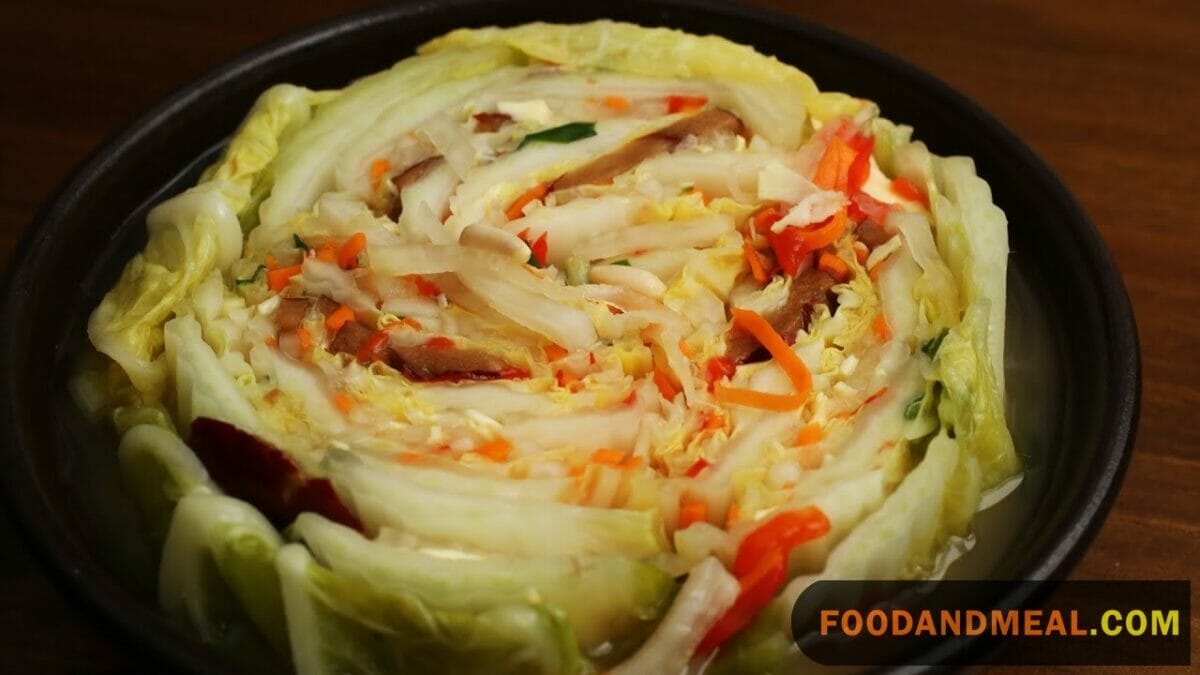
White Kimchi Recipe
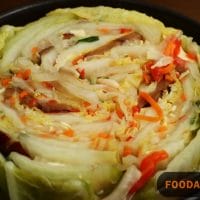
WHITE KIMCHI
Equipment
Ingredients
- 6 tablespoons coarse kosher salt, divided
- 1 large head napa cabbage, trimmed and quartered lengthwise with root end left intact
- 1 tablespoon sugar
- 2 small jalapeño chiles, seeded and quartered
- 10 scallions, 6 cut into matchsticks and 4 thinly sliced
- 7 garlic cloves, 3 of them minced, 4 thinly sliced
- 1 1/4 pounds carrots, shredded
- 3 -inch piece fresh ginger, peeled and minced
Instructions
- Mix 5 tablespoons of the salt with 6 cups water in a stockpot.
- Add the cabbage, placing it cut-side up. Top with a heavy plate if necessary to keep the cabbage submerged in the salty water. Let stand at room temperature for at least 8 hours.
- Drain the cabbage, discarding the liquid, and rinse in cold running water.
- In a large bowl or canning jar, mix the remaining 1 tablespoon salt with the sugar and 4 cups water. Mix well to combine.
- In a large bowl, mix together the jalapeño chiles, scallions, garlic, carrots, and ginger.
- Stuff a small amount of this vegetable mixture between each of the cabbage leaves. Place the stuffed cabbage into the prepared brine in the bowl or jar. Top with a heavy plate to keep the cabbage submerged in the brine, and let sit at room temperature for 12 hours. Transfer to an airtight container.
- Put in the refrigerator and, if possible, let sit for another 12 hours before serving.
- To serve, remove the cabbage quarters from the brine and cut into 1-inch slices.
Video
Notes
kimchi for a more colorful side dish.
Nutrition
© Food And Meal
This website provides approximate nutrition information for convenience and as a courtesy only. Nutrition data is gathered primarily from the Spoonacular Database, whenever available, or otherwise other online calculators.
Cooking Tips
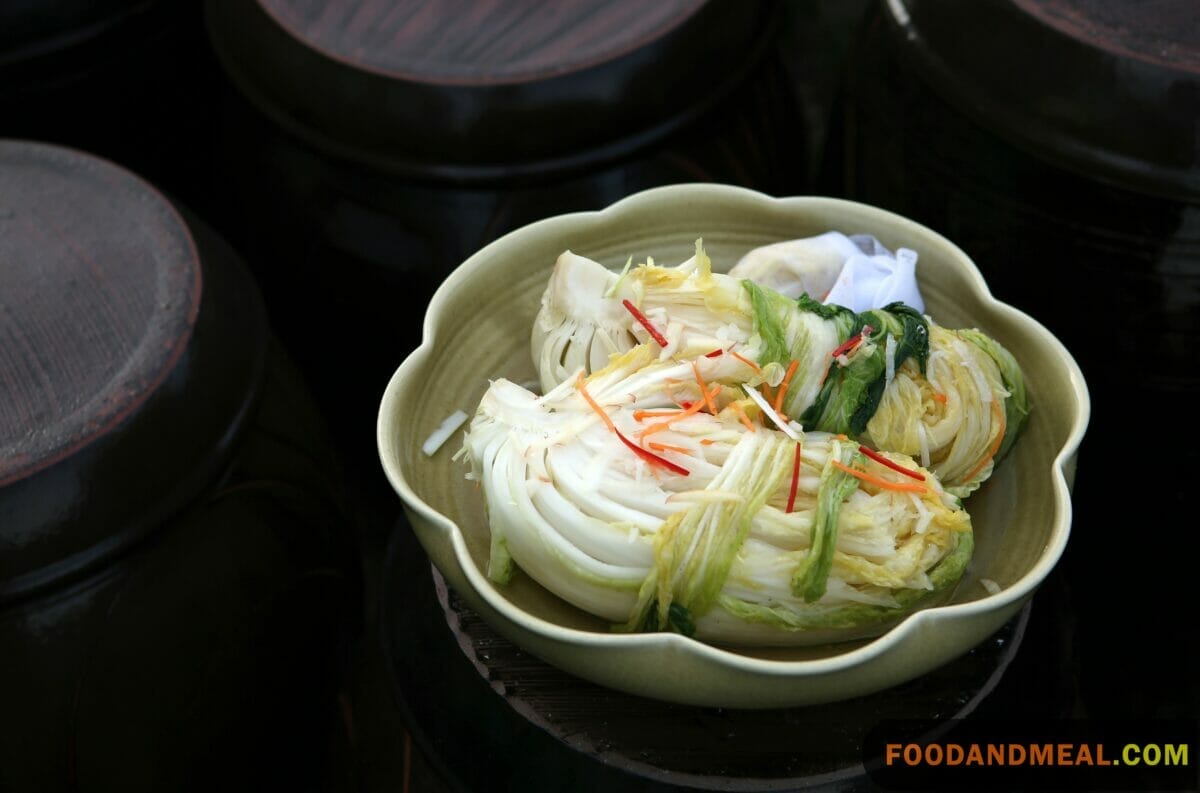
Firstly, begin with quality ingredients to achieve a fragrant and delicious kimchi. Choose the finest Napa cabbage, Korean white radishes, and the freshest carrots you can find.
Instead of using a substantial amount or omitting it altogether, apply the spicy kick from black pepper and the heat of white pepper to your white kimchi.
Experiment with aromatics like ginger, garlic, and green onions to create multiple layers of flavor without compromising the gentle nature of the dish.
The fermentation process is also an art that demands patience. Let your white kimchi ferment at a slightly lower temperature and for a longer period to produce complex and distinctive flavors.
Explore the aesthetic presentation of your white kimchi by arranging the vegetables thoughtfully in the jar, creating an eye-catching tableau before the tasting begins. It’s not just about the flavors; it’s about the entire experience.
Lastly, share the joy of cooking. White kimchi is a symbol of balance and harmony. It’s not only about the taste but also the communal experience. Share your white kimchi with family and friends, relishing in the delight of introducing them to the gentle, refined side of this traditional Korean dish.
Serving Suggestions
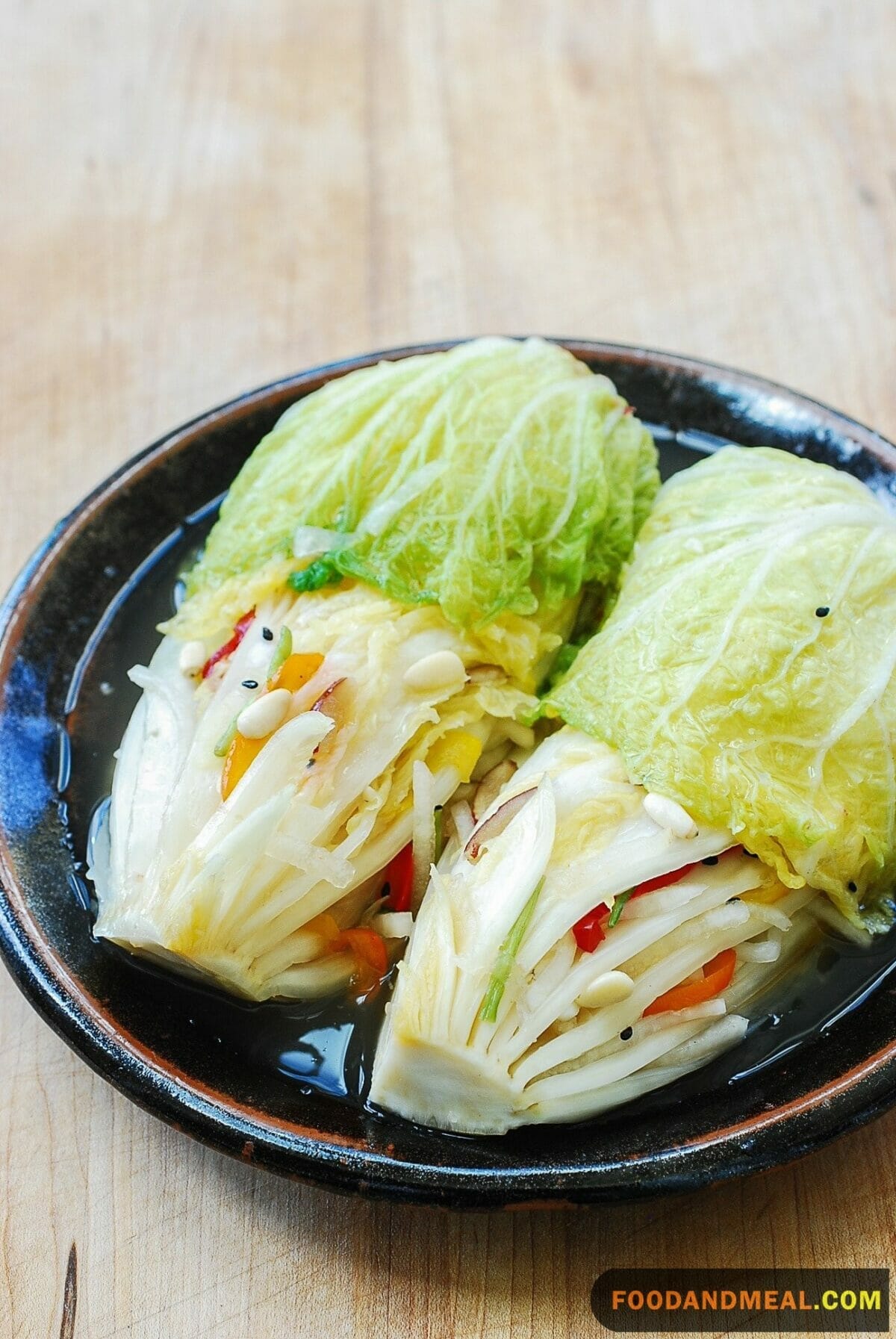
White kimchi, celebrated for its gentle flavors and crisp texture, serves as a versatile accompaniment across a spectrum of culinary delights. Paired with beef stock, it offers a refreshing counterpoint to the robust broth. In seafood dishes like miso salmo and fish tacos, the mild notes of white kimchi complement the freshness of the fish without overshadowing its natural flavors.
For ramen enthusiasts, whether indulging in the savory depths of miso ramen or the delicate balance of shio ramen, white kimchi stands as a delightful side, imparting complexity to the broth. It harmonizes beautifully with pork chasu, creating a pleasing interplay of textures and tastes.
Venturing beyond traditional fare, white kimchi adds a distinct twist to global dishes such as bunny chow, enhancing the South African curry-filled bread with its fresh and zesty profile. In cheesy delights like cheese dogs or cheese corn, the mild kimchi provides a satisfying crunch that complements the richness of the cheese.
Whether accompanying boiled pork, dashi eggs, or tuna satay, white kimchi contributes a unique element to each dish, striking a harmonious balance. Even in the realm of spicy kimchi stew, traditionally made with red kimchi, white kimchi serves as a palate cleanser between bites, offering a milder interlude.
Frequently Asked Questions of White Kimchi
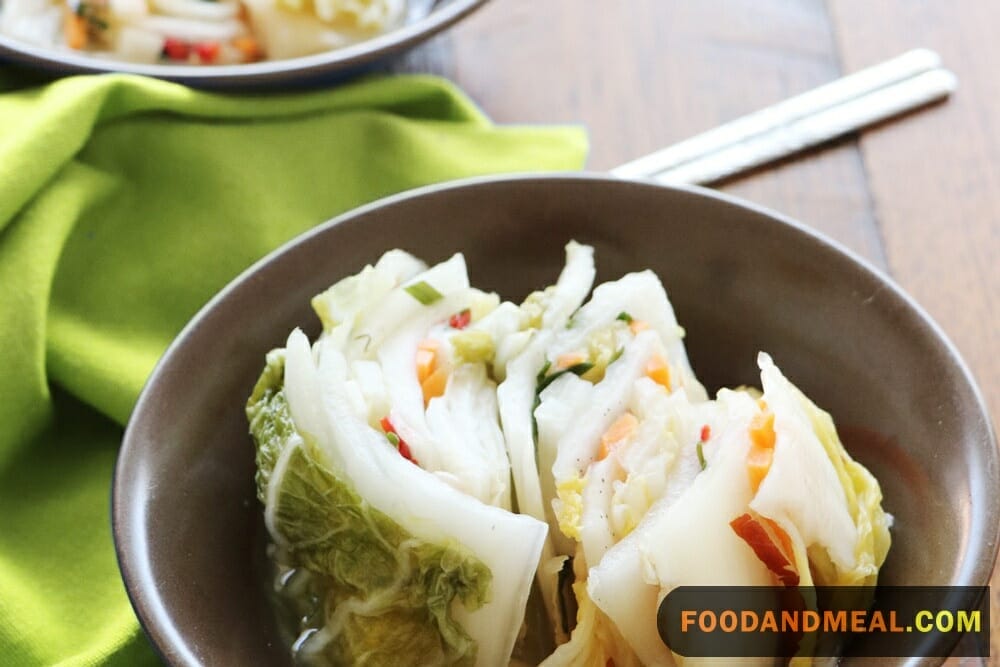
- What is the difference between white kimchi and normal kimchi? The main difference lies in the absence of red chili pepper in white kimchi. While traditional kimchi features a bold red color and a spicy kick, white kimchi is milder and often incorporates additional fruits or sweeteners, resulting in a more delicate flavor profile.
- Is white kimchi good for you? Yes, white kimchi is a nutritious option. Like traditional kimchi, it is a good source of vitamins, minerals, and probiotics, which promote gut health and aid digestion. The absence of red chili pepper makes it a milder choice for those sensitive to spice.
- What does baek kimchi taste like? Baek kimchi, or white kimchi, has a mild and slightly sweet taste compared to traditional kimchi. It is characterized by its refreshing crunch and a more nuanced flavor profile, as it lacks the bold spiciness associated with the red chili pepper in regular kimchi.
- What is the history of kimchi? Kimchi has a rich history dating back centuries in Korean culture. It was initially a way to preserve vegetables, using the natural fermentation process. Over time, it has become an integral part of Korean cuisine and is enjoyed worldwide.
- Is kimchi spicy? Kimchi can vary in spice level depending on the recipe and personal preference. Traditional kimchi often has a spicy kick due to the use of red pepper flakes, but milder versions can also be created.
- Can I make kimchi at home? Absolutely! Making kimchi at home is a rewarding experience. With the right ingredients and steps, you can craft your own delicious batches of kimchi that cater to your taste preferences.
- Is kimchi healthy? Kimchi is known for its numerous health benefits. It’s a rich source of vitamins, minerals, and probiotics, which promote gut health and aid digestion. Its fermented nature also contributes to its nutritional value.
- How do I store kimchi? After the initial fermentation, store kimchi in a sealed container in the refrigerator. This slows down the fermentation process, allowing you to enjoy it over an extended period. Always use clean utensils to prevent contamination.
- Can I use kimchi in cooking? Absolutely! Kimchi is a versatile ingredient that can be added to various dishes. It can enhance the flavor of soups, stews, fried rice, noodles, and even sandwiches.
- Does kimchi have vegan options? Yes, there are plenty of vegan kimchi options available. Instead of fish sauce, vegan recipes often use alternative ingredients to achieve the same umami flavor.
Conclusion
In conclusion, the world of kimchi is a vibrant tapestry of flavors, each type telling a unique story of tradition and innovation. From the bold and spicy notes of traditional kimchi to the delicate and nuanced palette of white kimchi, these dishes have become cultural ambassadors, transcending borders and captivating taste buds around the globe.
As we’ve explored the varieties and answered common questions about kimchi, the versatility of this Korean delicacy shines through. Whether you’re savoring the rich history of kimchi, experimenting with homemade batches, or exploring its diverse applications in cooking, the journey is as enriching as the flavors themselves.
Hi! I'm Nazia of ‘Nazia Cooks’, a self-taught baker and cook residing in Chennai. Rooted in the rich South Indian culinary landscape, my palate has expanded to embrace global flavors. I revel in crafting fusion dishes, melding traditions to birth unique tastes.



